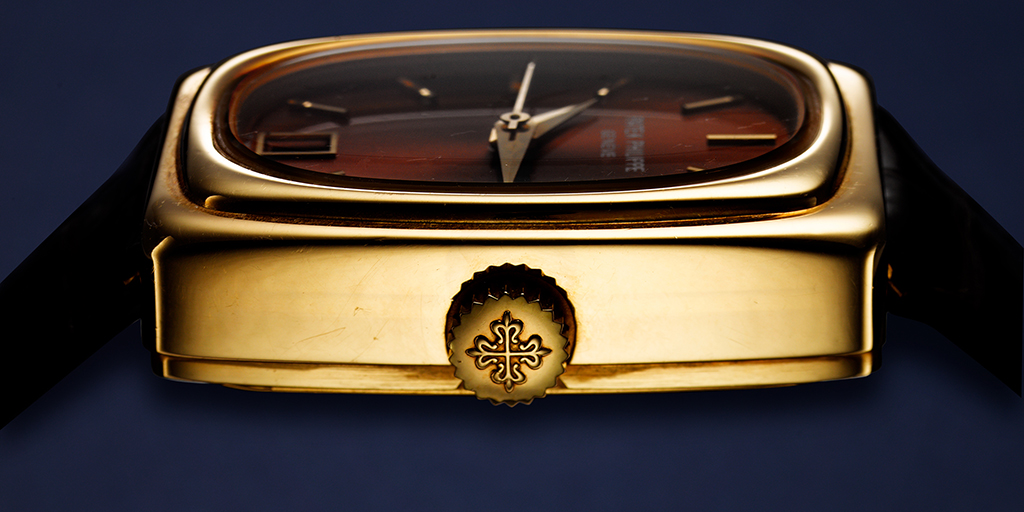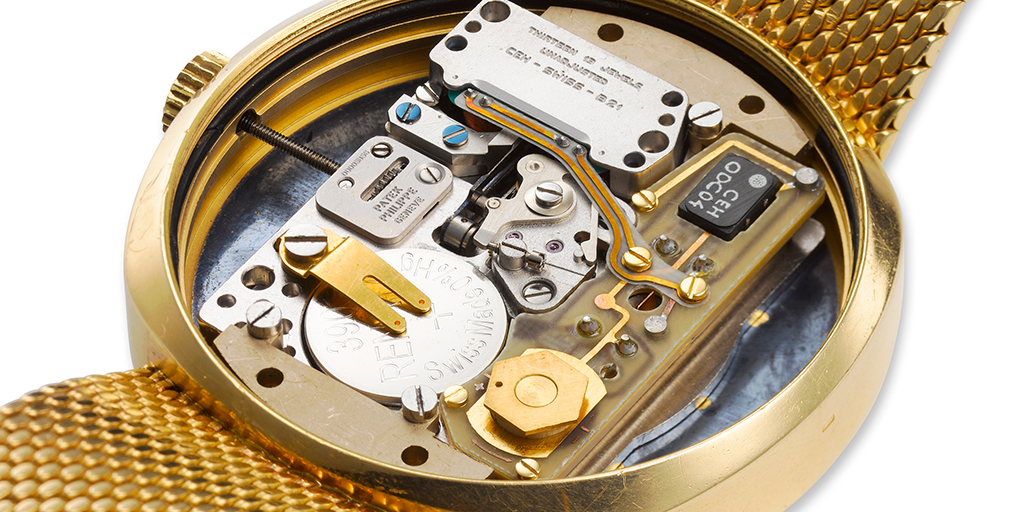In the history of horology, there have been few times more dynamic and more impactful in terms of progress than the Quartz Revolution. This period in the 60s and 70s changed the face of watchmaking forever. It was the pinnacle of hundreds of years of development in the quest for timekeeping accuracy as well as signaling the end of traditional watchmaking… or so we thought. Echoing the social and political upheaval of the time, 1969 became a year to remember and the dawn of a new era. This was the year of the launch of the Beta 21, and the beginning of Patek Philippe’s foray into quartz wristwatches.
For those quartz haters out there, stop reading now. For the rest of you, please enjoy the images and this story of the unexpected surprises of the references 3587 and 3603. You won’t be disappointed!

A Swiss quartz movement
The story begins in 1962 when approximately 21 companies came together to form the Centre Electronique Horloger (CEH) in Neuchâtel. The vision of this organization was to create a high-end Swiss equivalent of the quartz movement that had come from new Asian competitors and was on the verge of disrupting the market. Companies such as Patek Philippe, which was at the forefront of developing electronic timekeeping technologies, as well as Omega, Piaget, Rolex, and IWC and many others came together to research and create a quartz movement that would keep the Swiss on top. It was the culmination of a horological Cold War and this was the concerted nuclear attack: the Beta 21!
I can imagine the Swiss watchmaking executives in a bunker deep underground in Neuchâtel discussing the pros and cons of developing such a movement. On one hand, it may have felt that they were working towards mutually assured self-destruction; on the other, it may have felt like they were making history in creating something that had never before been seen. The result: the Beta 21, which was legendarily described as being produced by the ‘21’ companies that had banded together to create it. In the end, approximately 6,000 of these movements were made and shared by the conglomerate. Each brand had its own design aesthetic and each watch was a vision of what a watch should and could look like in the future. A ‘Jetsons’-era interpretation of time and space on the wrist.
Patek’s first futuristic watch: ref. 3587
The price was also out of this world. Patek Philippe’s first Beta 21 watch, the ref. 3587, retailed for 3,500 USD when launched in 1969. Compared to 2,200 USD for a ref. 2499, this certainly made a statement – and the price difference then and now between the two references makes a huge statement! Furthermore, the design made an impact that is still the talk of the watch community 50 years later – a massive chunk of gold, virtually a brick, of precious metal on the wrist.
The ref. 3587 two-piece cases were made by Atelier Reunis (casemaker mark 28 as seen in the inside case back). Massive in scale, these were the largest wristwatches made by Patek Philippe in the 20th century. It was not until the dawn of the 21st century that we started seeing cases of this size and larger from Patek Philippe. Atelier Reunis made some of the most important cases for Patek during this time and it is an interesting historical footnote that the company was located in the Geneva building that now houses the Patek Philippe Museum. Wearing a ref. 3603 on my wrist while at the museum recently, I had the pleasant feeling of knowing that I was bringing this watch back to its exact birthplace. (Based on some informed sources, this case was mostly likely made on the second floor.)
The dial of the ref. 3587 tells even more of the story. Made by Stern Freres, the dials were unlike anything anyone had seen before. The signature blue dial – made in the same blued gold as the signature design of the Ellipse – has a two-tone finish, the outer edge masked in a matte finish to highlight the green seconds markers. The luminescent 5-minute markers are set in thick gold batons and the massive hands are lumed. A gold framed aperture highlights the date and, no surprise given the timing, an APRIOR OSWISSO mark signature sits under the 6 o’clock baton; very appropriate in this case considering the batons and even the dial plate were gold. Two other dial variations were available for the ref. 3587 including a gilt dial and a two-tone silvered dial. There are two bracelet options for this model: the ref. 3587/1 has a mesh bracelet and the ref. 3587/2 has the now famous and very thick ‘holed’ bracelet that resembles a cheese grater. Interestingly, these bracelets were made by Pforzheim in Germany for Patek Philippe. The strap versions of the ref. 3587 were made mostly without lugs yet there are a few ref. 3587s in existence that were made with lugs.

The rare quartz Ellipse
In 1973, Patek released it next evolution of the Beta 21, the ref. 3603. Reflecting the explosive interest in the Ellipse watch, the ref. 3603 married the case and dial design of the ever-popular Ellipse with the new quartz movement. Nicknamed the ‘Grande Ellipse’ the ref. 3603 was well received by the market but made in very few examples (fewer than 120). Staying in the product line until 1983, this reference was offered concurrently with much thinner and much smaller references that utilized smaller quartz movements at Patek Philippe.
Like the ref. 3587, the ref. 3603 had a two-piece case made by Atelier Reunis but it had a snap back, unlike the water-resistant screw back of the ref. 3587. The dial options matched the Ellipse product line with a blued gold dial or brown autumn gold option. Bracelet options included an oyster-like integrated bracelet or a ‘tubogas’ style (‘tubogas’ translates literally as ‘gas pipe’ and is the name given to a type of chain formed from a pair of interlocking gold strips wrapped tightly together. This forms a flexible and hollow tubular bracelet that requires no soldering). Strap versions required a massive 22 mm wide strap. In all, fewer than 500 Patek Philippe watches with the Beta 21 were ever made but these models are finally getting the respect they deserve for their unique place in the company’s history, for their bold design, and for the unique 1970s vibe. Next time you try on and feel the Beta 21 literally humming on your wrist as you watch the sweep seconds whirl around the dial, you will understand. This is a watch that deserves attention, respect, and a knowing smile – the Beta 21 will live on as the cases and dials it inspired are finally respected as wearable works of modern art.
Visit the Collectability Shop to see the Beta 21.



